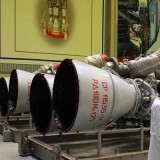Energy considerations in aviation: How realistic are alternative energy forms?
With over 35 years in management, science, and consulting, Dr. Klaus Radermacher KRBE GmbH brings a wealth of experience in analyzing and assessing transportation systems. His innovative approach integrates infrastructure and movement processes into holistic CO2 and energy comparisons.
Follow Dr. Klaus Radermacher’s LinkedIn newsletter “Think. Mobility. Differently.” for regular insights on mobility concepts and transportation systems.
The views and opinions expressed in this column are solely those of the author and do not necessarily reflect the official policy or position of AeroTime.
A key feature that has made aviation successful in recent decades is the fact that the energy required to transport hundreds of passengers and their luggage over thousands, sometimes tens of thousands of kilometers, could be transported within the aircraft. This is quite different from the transportation on a very restricted grid, e.g., a rail network, where the limitation of use of the rail network allows to provide the required propulsion energy “on the move” via an electric grid.
The unprecedented flexibility of aviation, which does not require any “path infrastructure” between the “node infrastructure” of airports, requires propulsion energy to compensate for this, which is overall appropriate in terms of volume and weight (mass), and which is also made available time-efficiently within the respective aircraft.
As of today, almost all aviation is based on kerosene or jet fuel. At this point, there is no need to further differentiate between particular specifications of jet fuel which might be used depending on weather conditions, etc. The energy-related chemical and physical properties of the different variants are very much the same.
What amounts of energy are we talking about?
Energy is usually measured in Joule (J), whereas 1 J is equal to 1 Watt (W) of electrical energy over the time of 1 second, 1 J = 1 Ws. A more prominent and more practical unit for electrical energy is Kilowatt hours (kWh), which means that we are looking at 1,000 Watts and 3,600 seconds in 1 kWh. A simple calculation shows us that 1 kWh is equivalent to 3,600,000 Joule, or 3.6 MJ (Megajoule). Of course, 1 kWh is also the amount of energy provided when we have an electrical power of 2,000 Watts used for over 30 minutes, or 10 kW for just 6 minutes.
In physics, the energy of 1 Joule is also equal to 1 Newton meter (Nm), Newton (N) being the physical unit for force. In the past, units like pound-force, pond, and kilopond (kp) were commonly used, but for the sake of simplicity, we stick to the SI system in this article; conversion tables for the other units can be found in. For physics enthusiasts: 1 Newton is equal to the “force required to accelerate 1 kilogram of mass at a speed of 1 meter per second squared” (1 m s-2). (Promise: No more physics formulas in this text from now on.) Put in simpler terms: The thrust needed for a plane to fly is dependent on the plane’s overall mass during the acceleration phase, its speed, the air density, which differs with the altitude and several other factors.
Jet fuel and its properties
The widely used Jet A-1 fuel contains 43.15 MJ of energy per kg. At a temperature of 15 degrees Celsius, the specific weight is 0.804 kg per liter.
Large widebody aircraft serving intercontinental routes have a fuel capacity of more than 100 tons. (A330neo: 111 tons, B787-9 Dreamliner: 101 tons, A380 up to 250 tons). 1 (metric) ton of Jet-A1 fuel stands for exactly 1,000 kg of mass, for 1.244 m³ (1,244 liters) in required tank volume and for 43.15 GJ (Gigajoule) of energy. Converted into electrical energy, this is as much as 11.99 MWh (Megawatt hours).
With this particular knowledge about kerosene’s energy content, we can look at potential alternatives.
Energy storage capacity of batteries
When will there be airplanes that can be operated on electric power generated sustainably, i.e., wind -, solar -, or waterpower? This is a question that has been asked quite frequently. Although there is a lot of research going on, my perception is that it will be a very long time before we see this happen, at least when looking at the mass market of long-distance aircraft seating hundreds of passengers. For niche markets, i.e. small planes and short distances like island hopping, solutions are likely to be available much faster.
Although incredible performance improvements have been achieved for batteries in recent years, we have to admit that we are currently looking at battery technology where 1 kWh of energy requires a battery that weighs anywhere between 3 and 6 kilograms.
Large electric vehicles with 100 kWh battery packs easily have a battery weight of 600 kg or more to be moved around at all times. The rather large difference in weight is determined by another important property of the battery: how fast can it provide the energy stored in it; how fast can it discharge the energy it contains?
For high power consumption, for example during the takeoff phase of a flight, enormous power is required and in a conventional jet this is provided simply by burning much more fuel per second compared to the fuel burn during cruise flight. Using battery power, it would have to be guaranteed that the batteries are capable of discharging sufficient amounts of energy and, unfortunately, there is a reciprocal relation: the more electrical power per unit of weight that can be stored in a battery (energy density), the lower the maximum power output of the battery (power density) and vice versa. These specific properties of batteries are shown in so-called Ragone plots.
But anyway, let us assume we can store 1 kWh of energy in a battery of 4 kg. For the almost 12 MWh of energy in 1 ton of Jet-A1, this would require 12,000 times 4 kg, 48 tons! If the aircraft requires 60 tons or even 100 tons of kerosene to transport 300 or 400 passengers over distances of 10,000km or in extreme long-haul flights, even 14,000km, we are already in a range of 2,880 tons or 4,800 tons of battery weight. Simply impossible.
But wait. This is where the physics expert will step in. There is another aspect to be considered: engine efficiency.
Today’s jet engines have an overall efficiency of 30% to 40%, while electric engines have around 90%. Mechanical engineering efficiency describes a ratio between the overall energy put into a system, and the amount of useful energy for the specific purpose, in the case of a jet engine this is generating thrust. To spoil the story right away, 100% efficiency cannot be achieved in any system, this would be a perpetuum mobile, impossible to construct as the laws of thermodynamics teach us. If we assume that our jet engine has an efficiency of 35%, this means that only about 15 GJ of energy are being used for thrust generation out of each ton of burned fuel. Besides the thrust an enormous amount of heat is generated when burning the fuel and, unfortunately, most of the energy goes into that.
By the way, this is not a specific deficiency in jet engines but is true for all combustion engines. As a matter of fact, hardly any engines have been trimmed towards efficiency to the extent of jet engines.
Back to our comparison with batteries: If we had comparable electric engines which could utilize 90% of the input energy, 4 kg of battery would provide 0.9 kWh (3.24 MJ) usable energy. To get 15 GJ of usable energy from 1 ton of input energy, we would still need a little more than 18.5 tons of batteries. For long-haul flights with 60 tons or even 100 tons of fuel in the tanks at takeoff, we would be in the range of 1.110 or even 1.850 tons just for the batteries. Still not feasible.
And at least 1 other engineering aspect needs to be understood. Today’s aircraft have larger maximum takeoff weights than maximum landing weights. This is the reason it is sometimes necessary to dump fuel in emergency situations when the plane needs to land shortly after takeoff. The weight of batteries does not change depending on whether they are charged or discharged.
How much stronger would gears have to be, and how much longer would runways have to be if a plane would not reduce a large amount of its takeoff weight during the flight?
Hydrogen
Hydrogen is often considered a clean source of energy for the future, which is only true if the hydrogen itself is generated with sustainable energy. Just like hydrocarbons, i.e., kerosene, hydrogen can be burned together with oxygen from the air and the emission gas is only water vapor. Many engines that currently burn hydrocarbons could even run on hydrogen without major changes. This sounds really good, but we also have to look at some chemical and physical properties of hydrogen before we become too enthusiastic.
Hydrogen, the lightest and smallest of all elements in the periodic table of elements, has the highest energy density relative to its mass but, unfortunately, an incredibly low energy density per volume.
1 kilogram of hydrogen stands for about 120 MJ, almost three times as much as kerosene. But, since the hydrogen is gaseous at normal conditions and only becomes liquid at minus 253 degrees Celsius, on kg of hydrogen under normal conditions (20° C, 1 bar) requires more than 11 m³ (11.000 liters) of volume. So, gaseous hydrogen provides 120 MJ of energy in the same volume, where kerosene gives us 590,360 MJ.
To get a reasonable energy yield from hydrogen, the energy density must be increased, not in terms of mass but in terms of volume. This can be achieved by liquefaction by cooling to minus 253 °C or by compressing the gas. Cooling to such extreme temperatures is difficult and requires enormous amounts of energy. Compression is used, for example, in hydrogen cars and trucks. Hydrogen is compressed to up to 700 bars (10,153 psi), sometimes even more, which requires tanks suitable for such pressures. Steel is already used for such tanks, which makes them very heavy. Research is being conducted into tanks made of much lighter composite materials (carbon fiber reinforced plastics, CFRP, CRP), which will certainly lead to lighter tanks in the future. For the use of such hydrogen tanks in aviation, however, it must also be taken into account that at cruising altitude the outside air pressure is much lower than on the ground and the tanks would have to be designed accordingly.
But, even at 700 bar pressure, only 40 kg of hydrogen fit into 1 m³, so 1 kg still requires the same volume (12.5 l) as 20kg of kerosene. If we consider the storage volume required, hydrogen provides us with 120 MJ of energy even at 700 bars, whereas kerosene (uncompressed) provides us with more than 860 MJ. Even if we ignore all the technical and structural aspects that would have to be solved when burning hydrogen in aircraft, we will need fuel tanks that are around seven times larger and that would also have to withstand pressures of 700 bars and more.
Any other alternatives?
Fuel cells are also considered a “clean” energy source for mobility and are used by some vehicles, especially buses. However, the “primary raw energy” of fuel cells is also hydrogen, so the same problems with energy density and pressure that have already been described are at stake here.
So far, no real alternative has been found for the immense amounts of energy that large aircraft require on long-haul flights. And that does not mean that flying as such is energy inefficient. In all considerations, we must always take into account that transporting 300 passengers over a distance of 10,000 kilometers means a total transport volume of 3,000,000 passenger kilometers (PKM). 400 passengers over 14,000 kilometers results in 5,600,000 PKM. Such volumes that aircraft handle during a single flight exceed the lifetime transport performance of other mobility vehicles such as cars, or require weeks, months or years for buses and trains.
Our considerations and calculations show very clearly that sustainable aviation fuels (SAFs) are absolutely necessary for more sustainable aviation and that their provision requires significantly greater efforts.
For further information on SAFs, I gladly refer to my column in AeroTime published in October 2024.The post Energy considerations in aviation: How realistic are alternative energy forms? appeared first on AeroTime.
With over 35 years in management, science, and consulting, Dr. Klaus Radermacher KRBE GmbH brings a wealth of…
The post Energy considerations in aviation: How realistic are alternative energy forms? appeared first on AeroTime.





